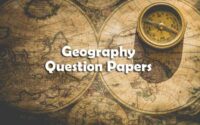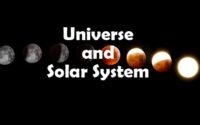SSC CGL Geography Questions and Answers
SSC CGL Geography Questions paper pdf for examination is given below. SSC Combined Graduate Level geography question papers direct download links are given in this section. Hence, download the SSC CGL Geography Previous Paper pdf below.

SSC Combined Graduate Level Geography Previous Papers Pdf help the applicants in their preparation. SSC CGL Geography previous papers are available here to download. This is the good news for the candidates who are preparing for SSC Combined Graduate Level.
Aspirants can download SSC Combined Graduate Level Model Papers on Geography pdf through online mode. Applicants who are preparing for SSC Combined Graduate Level written exam can download SSC CGL Geography Sample questions from our website for free.
Questions and Answers on Geography for SSC CGL
1. Which one of the following statements does not describe geography?
(A) It is an integrative discipline
(B) Its core concepts are space, place and time
(C) It is subjected to dualism
(D) It studies man-environment relationship
2. Who popularized the idea of ‘Geography as a study of areal differentiation’?
(A) Carl Ritter
(B) Bernhard Varenius
(C) Richard Hartshorne
(D) Immanuel Kant
3. Who was associated with teleological concept in geography?
(A) Carl Ritter
(B) Oscar Peschel
(C) Von Humboldt
(D) Friedrich Ratzel
4. Chicago school of sociology has immense contribution to the development of
(A) Cultural geography
(B) Urban geography
(C) Behavioral geography
(D) Agricultural geography
5. Who was NOT associated with environmental determinism?
(A) Elsworth Huntington
(B) William Bunge
(C) Halford Mackinder
(D) E. C. Semple
6. In ‘Morphology of Landscape’, Carl Sauer presented his idea of
(A) Cultural landscape
(B) Possibilism
(C) Social ecology
(D) Landschaft
7. Location theory in economic geography does NOT include
(A) Christaller’s Central Place theory
(B) Von Thunen’s land-use theory
(C) Weber’s industrial location theory
(D) Rostow’s stage of growth theory
8. Which one of the following is the earliest approach in human geography?
(A) Areal differentiation
(B) Critical geography
(C) Spatial organisation
(D) Post-modern geography
9. Heartland theory in geopolitics was propounded by
(A) Peter Haggett
(B) Karl Haushofer
(C) Halford Mackinder
(D) Derek Gregory
10. Who wrote the book ‘Explanation in Geography’?
(A) Doreen Massey
(B) David Harvey
(C) Ron Johnston
(D) Ron Martin
11. Spatial science school is based on the philosophy of
(A) Humanism
(B) Social ecology
(C) Positivism
(D) Realism
12. ‘Mental map’ is associated with
(A) Radical geography
(B) Post-modern geography
(C) Behavioural geography
(D) Humanistic geography
13. “Geography is concerned to provide accurate, orderly, and rational description and interpretation of the variable character of the earth surface.” This definition of geography is given by
(A) Richard Hartshorne
(B) Friedrich Schaefer
(C) Dudley Stamp
(D) E. C. Semple
14. The concept of genre de vie is associated with
(A) Friedrich Ratzel
(B) Vidal de la Blache
(C) Jean Brunhes
(D) E. C. Semple
15. Quantitative revolution in geography is NOT related to
(A) a turn from idiographic to nomothetic science
(B) emphasis on formulation of laws and theories in geography
(C) advocate on use of statistics and mathematical languages
(D) description and interpretation of areal differentiation
16. _____________ adopts qualitative methodologies that relied upon the ability of people to articulate the feelings and meanings that they associated with particular places is
(A) Humanistic geography
(B) Radical geography
(C) Behavioural geography
(D) Feminist geography
17. Who described the city of Los Angeles as a “polycentric, polycultural, and polyglot metropolis”?
(A) Michael Dear
(B) Yi-Fu Tuan
(C) Doreen Massey
(D) Gilian Rose
18. Who has propounded the concept of ‘historico-geographical materialism’?
(A) Edward Soja
(B) David Harvey
(C) Ron Johnston
(D) Neil Smith
19. A well-known book on environmental determinism titled the ‘lnfuences of Geographic Environment’ was written by
(A) E. Huntington
(B) E.C. Semple
(C) F. Ratzel
(D) W.M. Davis
20. Who coined the phrase ‘stop-and-go’ desterminism?
(A) Grifith Taylor
(B) E.C. Semple
(C) H. Barrows
(D) W.M. Davis
| RRB NTPC | AFCAT |
| TNPSC | SSC CHSL |
| MPSC | SSC CGL |
| UPSC | WBCS |
| CDS | BPSC |
21. Economic and/or political associations that are comprised of multiple, autonomous member states that cooperate to achieve a common purpose are known as
(A) Transnational corporations
(B) Supranational organizations
(C) Multiethnic societies
(D) Non-governmental organizations
22. A Hindu temple located in Texas is most likely the result of which kind of diffusion?
(A) Expansion
(B) Hierarchical
(C) Contagious
(D) Relocation
23. The English language belongs to which of the following branches of the Indo-European language family?
(A) Romanic
(B) Hellenic
(C) Celtic
(D) Germanic
24. Two prominent French ethnic islands in North America are historically located in which of the following areas?
(A) Louisiana and Quebec
(B) Minnesota and Newfoundland
(C) New Brunswick and California
(D) Utah and Ontario
25. According to Rostow’s stages of development, which of the following is true?
(A) All countries will eventually pass through each of the five stages of development.
(B) The colonial legacy will impede a country’s economic growth.
(C) Countries might not pass through each of the stages in a linear manner.
(D) The second stage is termed ‘Take-off stage’.
26. Which of the following is an example of quarternary economic activity?
(A) Entertainment
(B) Research and Development
(C) Oil production
(D) Transportation
27. Which one of the following individuals is engaged in a secondary economic activity?
(A) A computer programmer
(B) A city clerk
(C) The CEO of Suzuki Motors
(D) A production worker
28. The Human Development Index is a measure of both economic production and
(A) Social Indicators
(B) Unemployment rate
(C) Population density
(D) Income per capita
29. Alfred Weber’s least cost theory takes into account all of the following EXCEPT
(A) locating markets close to source materials
(B) transportation costs
(C) weight of raw materials
(D) consumer demand for the finished product
30. All of the following are true of globalization EXCEPT
(A) It involves the division of labour on an international scale.
(B) Proponents of globalization argue that increased economic integration will promote world peace.
(C) It involves cultural exchange, migration, trade, and technology.
(D) It has affected all areas of the world in very similar ways.
31. Bushman in southern Africa are also known as
(A) San
(B) Shona
(C) Zulu
(D) Hausa
32. Kalahari desert is the home of
(A) Bushman
(B) Mongo
(C) Bantu
(D) Zulus
33. The largest and most wide-spread language family is
(A) Indo-European
(B) Sino-Tibetan
(C) Afro-Asiatic
(D) Austronesian
34. Benelux countries include
(A) Belgium, Netherlands, and Luxembourg
(B) Britain, Norway and Liechtenstein
(C) Belgium, Norway and Liechtenstein
(D) Britain, Netherlands and Luxembourg
35. The Maasai are ________________ inhabiting southern Kenya and northern Tanzania
(A) Pastoralists
(B) Hunter-gatherer
(C) Agriculturalists
(D) Nomads
36. Which of the following is true regarding least developed countries (LDC) and most developed countries (MDC)?
(A) LDC have lower infant mortality rates than MDC
(B) LDC have higher standards of living than MDC
(C) MDC have lower illiteracy rates than LDC
(D) Economies of MDC have more reliance on agricultural production than LDC
37. Which of the following central place functions is most likely to have the highest range of goods and also the highest threshold population?
(A) A dry cleaner
(B) A Chinese restaurant
(C) An elementary school
(D) A cancer treatment clinic
38. According to Weber’s industrial location theory, location of industry is determined by
(A) Transport cost
(B) Labour cost
(C) Agglomeration economies
(D) All of these
39. The most developed country in the world in terms of HDI is
(A) Norway
(B) Switzerland
(C) United States of America
(D) Germany
40. Which one of the following activities is NOT a secondary sector activity?
(A) Iron Smelting
(B) Making garments
(C) Fishing
(D) Basket Weaving
41. The first stage of the demographic transition model says
(A) High birth rate and low death rate
(B) Migration increases from rural to urban areas
(C) High birth and death rates
(D) High life ecpectancy
42. Population pressure on an agricultural land is typically expressed as the
(A) Crude density
(B) Arithmetic density
(C) Physiological density
(D) Population density
43. According to Malthus’s population theory, which of the following is a preventive check on population?
(A) Famine
(B) Disease
(C) War
(D) Moral restraint
44. Arithmetic population density can be calculated by
(A) total land area multiplied by total population
(B) total land area minus by total population
(C) total population multiplied by total land area
(D) total population divided by total land area
45. The population of developed nations can be described as having
(A) lower life expectancy rate than less developed countries
(B) higher crude death rates than less developed countries
(C) higher crude birth rates than undeveloped countries
(D) lower natural increase than undeveloped countries
46. Baby booms are generally associated with
(A) periods of economic hardship
(B) increased education of women
(C) periods of economic prosperity
(D) increased number of women in the workforce
47. The term ecumene refers to
(A) the amount of time it takes a population to double in size
(B) the amount of land that is built on and the amount of land not developed yet
(C) regions under environmental stress due to overpopulation
(D) the number of farmers per unit area of farmland
48. The seasonal migration of livestock between lowlands and mountains is termed
(A) Step migration
(B) Transmigration
(C) Periodic movement
(D) Transhumance
49. Which of the following is NOT one of Ravenstein’s migration laws?
(A) Most migration is rural to urban.
(B) Migrants traveling long distances will likely settle in a big city.
(C) People in rural areas are more migratory than city dwellers.
(D) Most international migrants are young women.
50. Which country below has the highest concentration of Buddhists?
(A) South Korea
(B) Vietnam
(C) Sri Lanka
(D) Indonesia



